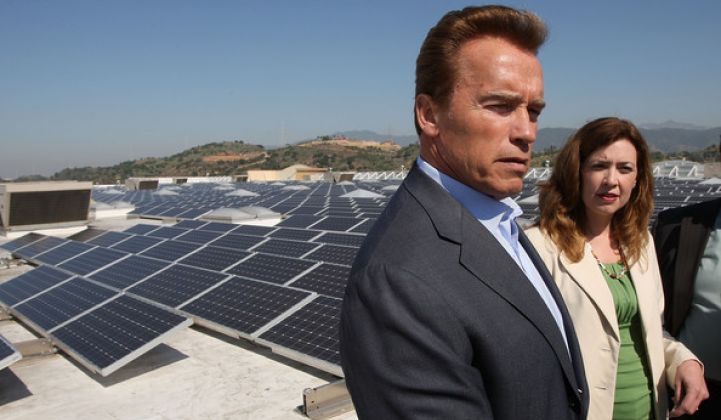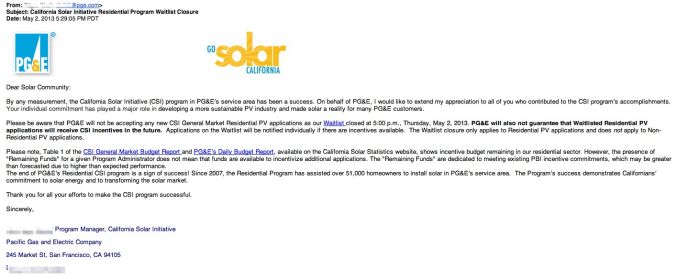The California Solar Initiative (CSI) program, which provides rebates for homes and businesses, is no longer providing rebates for homeowners in PG&E territory. That's terrific news. PG&E solar incentives are dead! Long live solar!
As a solar enthusiast, you may think I'm crazy for celebrating the upcoming demise of the single most effective state solar policy in the U.S., but it's true. The California Solar Initiative was the vehicle for accomplishing the goal of a million solar rooftops in California, established by Governor Schwarzenegger in 2005. The CSI program kicked off at the beginning of 2007 to encourage the installation of 2,000 megawatts of customer-owned solar in the state, leveraging about $2 billion in ratepayer "public goods" funds.
To be clear, there are still some rebates available for commercial systems in PG&E territory, as well as lower incentive level rebates in SCE territory. There are also plenty of rebates available for solar thermal systems. But PV incentives for homeowners are effectively gone -- and it won't cause even a blip in California's solar growth rates.
From the start, it was all about energy, jobs and the environment. The CSI program has been a rousing success in every one of these dimensions. As of the beginning of May 2013, California had installed 148,989 solar projects (including both the CSI and earlier California Energy Commission incentive programs) and 1,548 megawatts of solar, at an average cost per watt of $5.40 per watt (DC). And these figures do not include the state's utility-scale solar, which has 1,190 megawatts of operating capacity and 3,063 megawatts of capacity under construction.
The Solar Foundation has tallied up 43,700 solar jobs in California and 1,703 solar companies. The Foundation also points out that there are "only" 32,300 paid film and TV actors in California; unfortunately, it did not compare the lifestyle differences between Hollywood actors and rooftop solar installers.
Continued price declines in the cost of installed PV systems were the single most important factor in the success of the CSI program. These price declines were expected when the CSI program was established, and, although the declines did not arrive in the nice smooth line that was anticipated, the effect was the same. When both home owners and business owners realize that it's cheaper to make their own power than to buy utility power, adoption accelerates. It's an electricity paradigm shift -- just like the transition from landline phones to cell phones and from horses to cars.
Solar is being installed on a wide spectrum of buildings: affordable housing, new construction, commercial and public buildings, parking lot structures, and over 100,000 single-family homes. Significantly, I've seen a subtle shift in homeowner attitudes toward solar over the past decade: rooftop solar is no longer a granola, left-wing, rich-person indulgence -- solar has gone mainstream. It makes good financial sense. As in Germany, we no longer have to convince customers that solar works, because they see literally dozens of homes, business and schools with solar panels every single day. And solar keeps working; those systems that were installed ten or more years ago are still merrily kicking out the kilowatt-hours and running electric meters backwards.
But now is not the time to rest on our laurels. Two critical policies help keep solar operating in top gear, both in California and the rest of the U.S.: net metering and the 30 percent ITC. And both policies are facing active, organized, well-funded attacks from incumbent energy providers, including utilities and fossil fuel companies. We must strive to retain net metering in every single state, since utilities everywhere are trying to eliminate this simple and cost-effective incentive mechanism. And we must work toward an extension of the Investment Tax Credit for both residential and commercial systems, an incentive that is scheduled to expire at the end of 2016.
The reality is that policies like the CSI program, net metering and the ITC don't just appear magically out of thin air. They are the result of the sweat and effort of countless enthusiastic volunteers and policymakers, as well as generous financial contributions from companies and individuals in the solar industry. The solar industry will continue to grow, but we've got our work cut out for us since our opponents now realize how much of a threat solar can be to their existing businesses.
(click to enlarge)
***
Barry Cinnamon is a solar and renewable energy strategist and founder of Akeena Solar.




